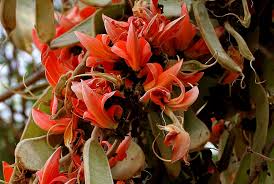The splendorous and brilliant orange of the tesu flower of the Palash tree is the reason for its famed sobriquet—the flame of the forest! Among its many uses, the tesu flower is used to make colour for the festival of Holi. The festival of Holi marks the advent of spring in the Hindu calendar, a festival for purging, bidding goodbye to the old and preparing for new beginnings. The occasion is celebrated by spreading the vibrant colours of spring among friends and family in the form of gulal or pinkish-red powder from hibiscus and rose, saffron-coloured powder from tesu, yellow powder from marigold along with coloured water that people playfully sprinkle on each other. The fond exchange of colour is accompanied by song and dance and the consumption of sweets and savoury delicacies that are native to different regions in India where the festival is being celebrated.

Tesu of the Palash Tree
The colours used during the festival of Holi were extracted from natural sources such as the tesu, hibiscus and marigold flowers as well as flowers of the Indian Coral tree. The Palash tree specifically blooms around springtime, and its bright orange hues are a harbinger of the oncoming transformation of climate and landscape. Birds, bees and other insects flock around the Palash tree, attracted to the orange colour of the flowers, helping pollination and natural reproduction of this tree species.

Making organic colour for Holi
Traditionally, the flowers are carefully collected from the trees where they bloom a couple of days before Holi. The petals are then gently taken apart from the stem and are left in the sun to dry. Once dry, the petals are ground by hand to create an organic, lush paste of colour that can be further dried to create a powder or used as a wet colour.
The natural colours procured from tesu and other bright-hued flowers have beneficial advantages for the skin and are not toxic to the environment in any way. Over time, due to the lack of availability of these flowering trees in urban areas and the cheaper manufacturing costs of industrial dyes—tesu has lost its symbolic and utilitarian value on Holi.
The Palash tree and so many others across India are revered for their capacity to provide the medicinal product, food, shade, spiritual succour and stunning visuals when in full bloom, to human beings and animals alike. It is important that as a culture, we use festivals as an opportunity to go back to our roots, most of which involve ritual and tradition that brings us closer to nature. At these times we should also reflect on the need for ardent conservation year-round of our natural resources that have spiritual, historical, social and economic significance for urban and rural societies alike for industry and day to day sustenance.

Very Informative article indeed, what mesmerizes me are the different ways in which Holi is celebrated across different regions of India.I have researched and compiled different traditions of Holi celebrations.
How India Celebrates Holi – plant trees using grow-trees.com